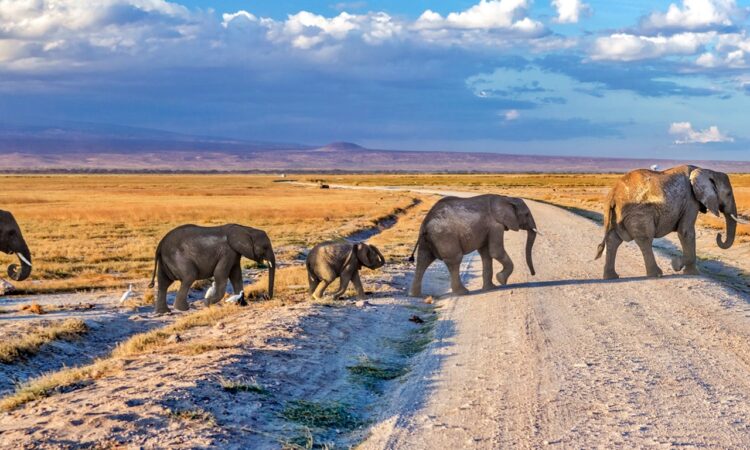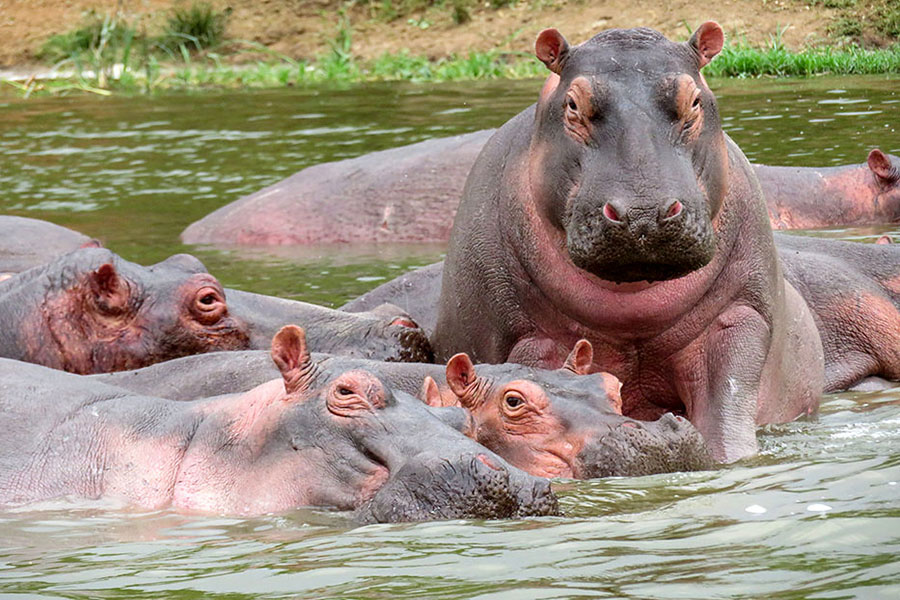Top Wildlife Animals Sighted on Kenya Safaris: Kenya is one of the greatest nations to visit for a safari to view wildlife wandering in their natural environment, with stunning scenery, clean shoreline beaches, and friendly people eager to show you around. A trip to Kenya is well worth your time and money since you will get to see the wilderness in its natural state and leave with many memories to cherish.

A Kenya wildlife safari to most of the national parks or game reserves will allow you to meet the Big Five; Lion, Elephant, Rhino, Leopard, and Buffalo, among other predators and grazers. Here is a list of wildlife that you will most likely witness while on your Kenya safari;
Cape Buffalos
One of the deadliest of the five great cats (Lion, Elephant, Rhino, Leopard, and Buffalo). The African Cape Buffalo may be found in practically all of Kenya’s national parks, game reserves, and wildlife conservancies. Lions enjoy it since they can’t run quickly.
Giraffes.
The tallest animal on the planet, at five times the height of an adult human. Giraffes are a sight to behold with your own eyes. They are one of three species found in Kenya’s national parks and wildlife reserves: Masai Giraffe, Reticulated Giraffe, and Rothschild Giraffe. The Masai Giraffe may be seen in most of the parks.
The Reticulated Giraffe is predominantly found in Northern Kenya’s Laikipia Conservancies and Samburu-Shabba National Reserve. The Rothschild Giraffe is an endangered animal that may be seen at Lake Nakuru National Park as well as Nairobi’s Giraffe Centre in Karen.
Zebras
Zebras are one of the most beautiful wild animals in Kenya, with two species: the Plain Zebra, which has broad, widely spaced stripes that are browner in females and black in stallions, and the Grevy’s Zebra, which has bat ears, narrow, close-set stripes, and an unstripped belly. The plain zebra is found in the majority of Kenya National parks, but the Grevy’s zebra is only found in the north-eastern conservancies and reserves.
Grevy’s Zebra is occasionally found in groups alongside Plain Zebra. Lions, hyenas, and hunting dogs may all kill both adult and young zebras, while leopards and cheetahs sometimes capture foals. Zebras have the ability to deliver a bone-crushing kick against predators.
African Savannah Lions
Feared by both wild animals and humans, the Lion is one of Kenya’s beautiful and daring creatures, recognized as the king of the jungle and the largest of the predators among the Big Five. A safari in Kenya would be incomplete without seeing a lion. The Masai Mara National Reserve in Kenya is home to several lion prides. Masai Mara is also home to black-manned lions. Lions may be found in the majority of national parks and wildlife reserves.
Impala
A medium-sized antelope that may be found in majority of Kenya’s national parks and wildlife reserves. Males have lyre-shaped horns, whilst females have no horns at all. A smell gland is located in a tuft of black hair on the bottom portion of the rear legs above the hooves. Impala are most active during the day in the early mornings and late afternoons.
Can be spotted in herds of 6-100 individuals moving over their vast home range. When disturbed, they take flight in a series of magnificent bounding hops, capable of leaping 10 feet in the air and 36 feet in breadth.
African Savannah Elephants
The biggest land mammal that is unmistakable and extremely gregarious, living in family units of a number of related adult females and their calves in groups of 10-15 individuals. The matriarch is an elderly person who leads the group.
A visit to Kenya’s Amboseli National Park will undoubtedly be worthwhile, as you will witness these gentle giants wandering the grasslands, eating, wallowing, and rubbing against trees or boulders. Tsavo East is home to red-dust elephants, a result of wallowing in Tsavo’s red sand. Your first contact with elephants will undoubtedly be unforgettable.
Rhinos
Rhinoceros are divided into two species: white and black rhinoceros. They are listed as an endangered animal species because their horns are thought to be therapeutic. White rhinos are more gregarious than black rhinos. Usually encountered as a solitary or as a female with a young one.
Adult males tend to be alone and territorial. Nairobi National Park, Lake Nakuru National Park, and Masai Mara Game Reserve are all good places to watch white rhinos. Nairobi National Park, Tsavo West National Park, and Masai Mara Game Reserve are also home to black rhinos.
Hippos
Rivers, lakes, and swamps in National Parks and Game Reserves are the most common habitats. They are nocturnal and frequently seen in groups of ten to twenty females and their young. Spends the day napping in the water or resting on sand banks, emerging at twilight to eat in the nearby grasslands. The Masai Mara is notable for having a huge population of hippo in the Mara River and Mara Talek.

Cheetahs
The fastest wild mammal in the planet, with a top speed of 70mph (112kph). Cheetahs may be identified from Leopards by the presence of pronounced black ‘tear-marks’ running from the inner corners of their eyes to the margins of their mouth. Cheetahs target medium and small antelopes, especially Thomson’s Gazelles and Impala. A Kenya safari to the Maasai Mara Game Reserve would almost certainly provide you with cheetah sightings. Cheetahs may also be seen in Amboseli, Tsavo, and Samburu.
Wildebeests
Wildebeests are one of the antelopes found in Kenya’s national parks and wildlife reserves. They like wide grasslands and acacia thickets. Large herds of hundreds of thousands can be found. The greatest concentration of wildebeests may be found in the Masai Mara-Serengeti eco-system. The annual wildebeest migration has thousands of wildebeests and zebras crossing the Mara River with predators on the lookout for the wildebeests, making for a stunning sighting between July and October.
Leopard
One of Kenya’s large cats and a member of the big five. Leopards are opportunistic hunters that can hunt at any time of day or night if they are not disturbed. It has spots and bards across its breast and rosettes on its body and upper limbs. Leopards are less common than cheetahs. Black leopards, sometimes known as ‘panthers,’ are simply melanistic leopards that have lately been spotted and photographed in Laikipia County.
Waterbucks
As their name implies, they are mostly found near sources of water and are the most water-dependent of all antelopes. Horns are only found on males. They are divided into two species: Defassa and Common Waterbuck. Waterbuck may be found in the majority of Kenya’s national parks and wildlife reserves. They are abundant in Lake Naivasha and Nakuru. Lions and hunting dogs occasionally feed on adults, while leopards and hyenas prey on calves.
Hyenas
The spotted hyena, stripped hyena, and aardwolf are the three species of hyena. All are available at Kenya’s wildlife attractions and national parks. The spotted hyena has the strongest jaws of any terrestrial predator, with extra-ordinary molar teeth for shattering bones. They are Africa’s most numerous big mammalian predator. The striped hyena is smaller and more uncommon than the spotted hyena. The aardwolf resembles a striped hyena, although it is smaller and predominantly an insectivore.
Ostriches
The ostrich is the largest bird that cannot fly but has strong, long, and powerful legs that let it to run at a pace of around 70km/hr. The male ostrich is black with white plumes on the wings and tail, whilst the female is greyish. It may be found throughout the majority of Kenya’s national parks. The Somali ostrich is a kind of common ostrich that may be found in Northern Kenya’s Samburu National Reserve.
Thomson’s Gazelles
A gazelle that is smaller than the grant’s. The majority of national parks and wildlife reserves have gazelles, commonly known as tommy with a black stripe on their body. Both men and females have horns, however females have smaller horns. Thomson’s gazelle creates a loose group of 5-50 females and their young, with a territorial male present. Thomson’s gazelles are extremely quick, reaching speeds of up to 50 miles per hour (80 kilometers per hour). Cheetahs, leopards, and hunting dogs are frequent predators.
In summary; Your trip to Kenya will undoubtedly be unforgettable since you will be able to view some of the world’s most diverse and abundant animal and bird life. Explore Rwanda Tours would gladly organize your Kenya Wildlife Safari. Allow our knowledgeable tour experts to assist you in customizing your wildlife safari.


